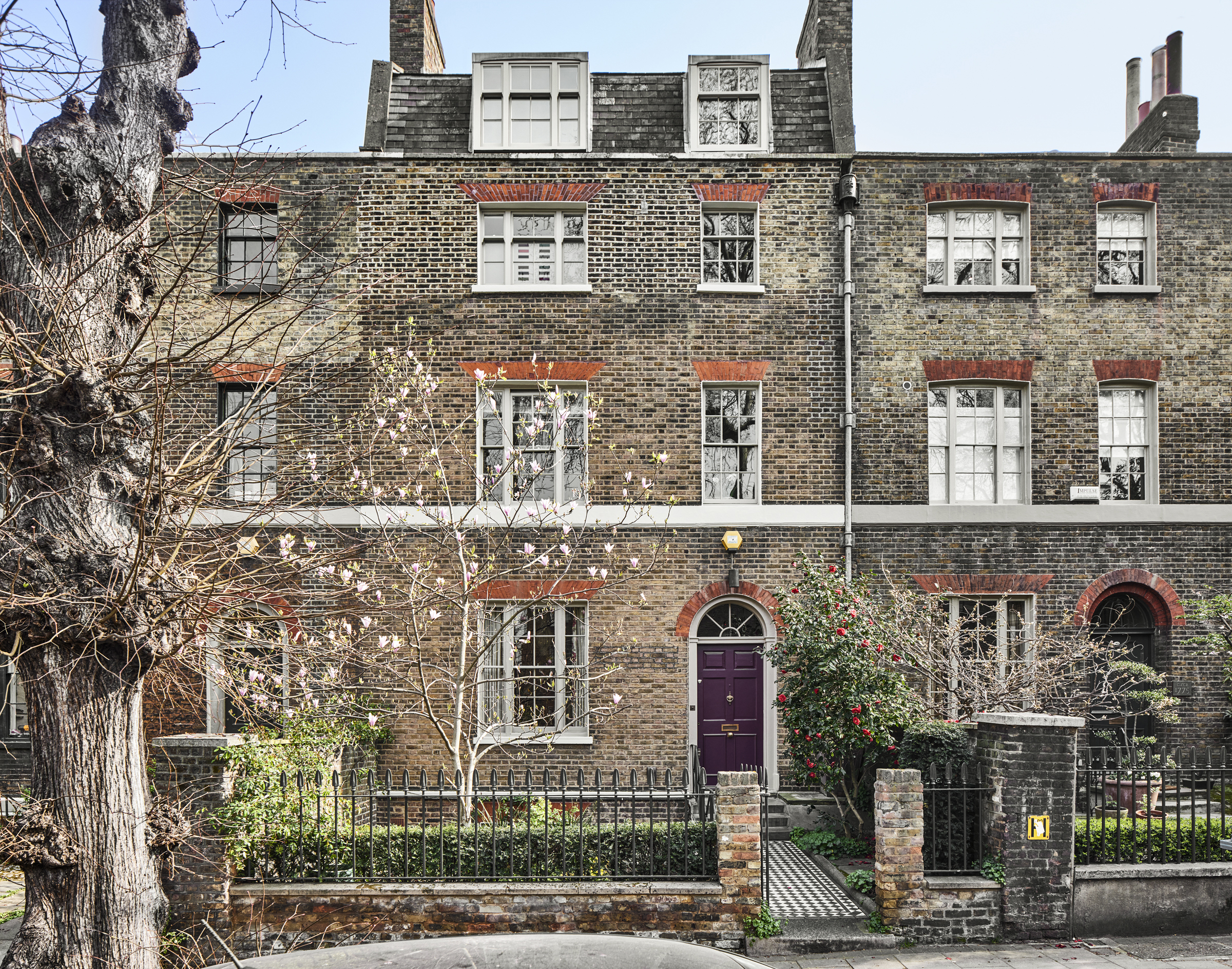The house is set far back from the road behind a private front garden, its splendid façade of red brick dressings, coped parapets, and towering slate mansard partially shielded by a single magnolia tree.
The ground floor enters to a hallway, its scale effectively modest in comparison to the grandeur of the rooms it precedes. To the left lies a library and reading room with built-in shelving and a wide sash window looking onto the front garden and street beyond.
A doorway links the reception at the rear. This stunning room combines the aged hue of wideboard Sussex oak floors with high, corniced ceilings and a trio of sash windows within the first of four curved bays looking out onto the private rear garden. One of these bays opens as a door and leads to steps to the garden. Both receptions have open fireplaces which retain their original chimneypieces around Edwardian hearths. Much of the panelling and many of the shutters throughout the house are also original.
Stone steps lead down to the lower-ground level, where limestone slab floors extend throughout. This superb open plan space is without compromise, benefitting from the influx of natural light at two aspects, excellent volume and direct access to the garden through an enormous double-glazed door.
The kitchen is positioned at the front. It was designed by Smallbone, arranged around a marble-topped island with an exposed 17th-century oak beam. Appliances are by
Miele and
Gaggenau. In one corner of the room is a larder with a bottle fridge and slate shelving. Beyond the stone steps, to the front, lies a utility, a guest cloakroom and a wine cellar, and beneath the front garden are tanked former coal drops for storage. Between the kitchen and dining space is a versatile seating area arranged around a gas-fired stove.
There are four bedrooms across the upper three levels. The two principal bedroom suites occupy the first and second floors and are set within the massive rear bays. The first-floor bedroom has built-in wardrobes lined in oak, and on the same level, there is a bathroom with panelled walls and stained pine floors. The second-floor bedroom is currently used as a study, with a wealth of built-in shelving and fitted wardrobes, and has an en suite shower room with a steam shower. There is a further bathroom on this floor together with a walk-in wardrobe hidden behind panelling on the landing and two further bedrooms on the floor above.
The Great Outdoors
The private garden to the rear is exceptionally long and wide. It can be accessed via stone steps from the ground floor reception or from the lower-ground kitchen and dining room, from which a large glazed door leads to a patio and paved steps upward to the garden. There is also access at the end of the garden, via an alleyway, from which garden deliveries can be made.
The garden itself is wonderfully planted on all sides, with mature trees dotted within and alongside its paved expanse. At the far end lies a charming wool-insulated garden studio with underfloor heating and an adjacent workshop/shed.
Residents’ parking is available on Camberwell Grove and for those with the vehicular or mere spatial requirements, a nearby single garage (and forecourt with space for two further cars) is available by separate negotiation.
Out and About
The house is brilliantly situated moments from Camberwell Church Street and its exciting culinary scene and a short walk from Bellenden Road, Peckham’s pretty village with its excellent selection of restaurants, cafes and good pubs.
The Camberwell Arms is of particular note, as well as local favourite
Theo’s Pizzeria on Grove Lane, modern Italian restaurant
Artusi is also nearby. The newly opened Grove Lane Deli is hugely popular for provisions, and there is a weekly farmer’s market on Camberwell Green.
The green spaces of Ruskin Park, Brockwell Park and Peckham Rye are all within easy walking distance, while local leisure facilities include the nearby Butterfly tennis club and Camberwell Green swimming pool. Local cultural distractions are plentiful and include the
South London Gallery and
Dulwich Picture Gallery.There are several excellent state and public schools in the area, including Dulwich College, James Allen’s Girls’ School, Alleyn’s School, The Villa Pre-Prep and Nursery, Dog Kennel Hill Primary School and Lyndhurst Primary School.
Denmark Hill station is a short walk away, running direct rail services to Victoria, Blackfriars and St Pancras International, and Overground services to Clapham Junction or Dalston Junction via Canada Water (Jubilee Line). Camberwell is also uncommonly well served by at least ten bus routes.
